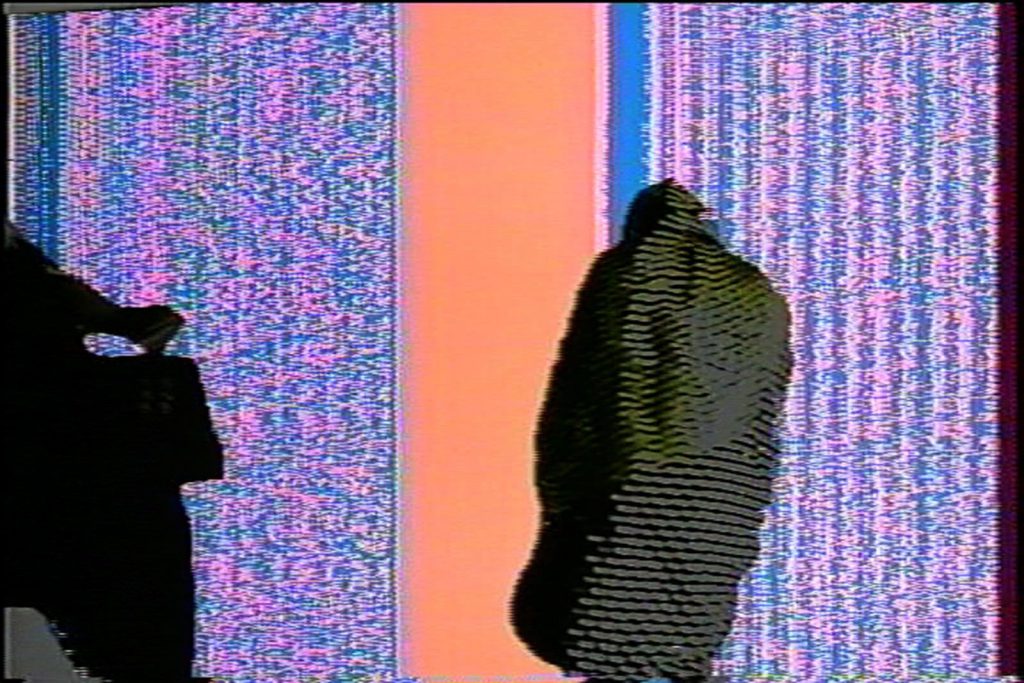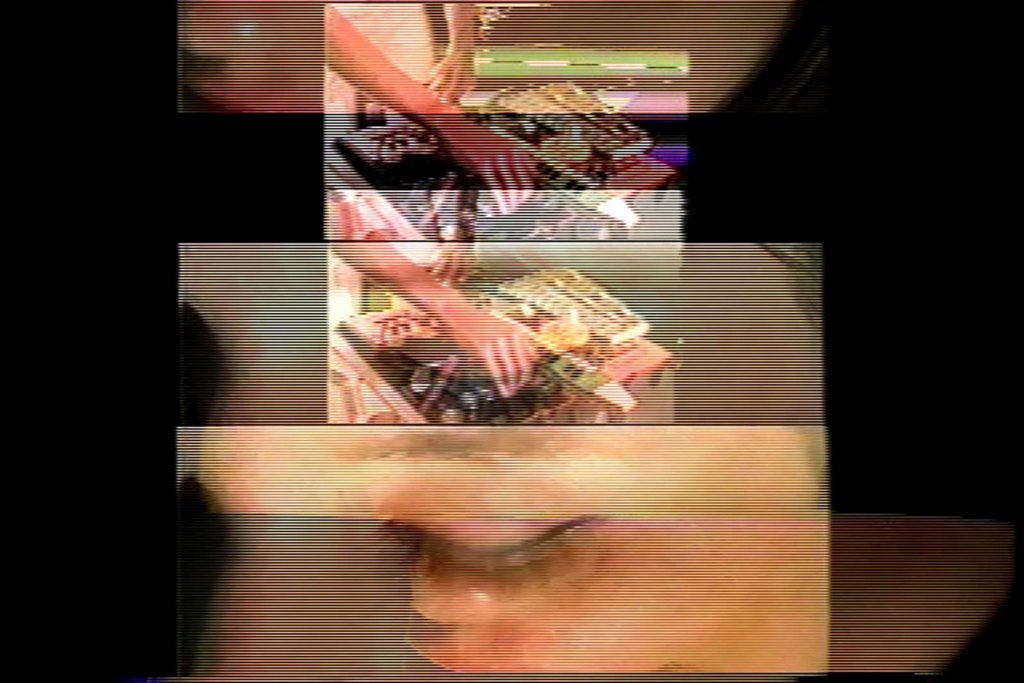Esp tv
Victoria Keddie & Scott Kiernan with Nathan Cearley
E.S.P. TV is an audio/visual organization devoted to broadcasting art and music events taped live before an audience. Their practice explores the analog media technologies of the past while simultaneously producing, distributing and archiving what amounts to tomorrow’s culture. Operated by Victoria Keddie and Scott Kiernan, E.S.P. TV has no fewer than 59 episodes to its credit and a VHS boxed set distributed through Printed Matter.

NC: Hi. We are going to conduct this entire interview in what appears to be a form of question and answer but which will in reality be a series of psychic conversations…is that okay?
SK: I think you already know the answer to that, Nathan.
VK: Psychic conversations.
NC: Tell me a little bit about your backgrounds prior to ESP TV?
SK: I had been running a project space in Williamsburg called Louis V. E.S.P. that I co-founded with Ethan Miller. The program reflected our shared interests and leaned heavily towards performance and/or exhibitions that were organized according to games or originated in unconventional ways. E.S.P. TV started as one of these shows in the space.
VK: Prior to E.S.P. TV I was working full time as a media archivist preserving sound and film. I was programming experimental cinema and sound events around the city. I started Optics O:O., a film based screening series that focuses on optical printing and early video with film. I co-formed the artist collective, OPTIPUS, and was merging strings with oscillators...
NC: What past audio visual projects, in the worlds of TV, film or art, inspired you?
VK: Perfect Lives by Robert Ashley, Soho TV, Nam June Paik and Merce Cunningham together, Mike Kelley’s Day is Done, Stan VanDerBeeks Cinemadome, The Outer Limits...
SK: Videofreex! Jack Goldstein’s short films. Early Bell Labs video experiments. Potato Wolf/MWF Video Collective. We really were blown away by this one Vancouver public access show we found called “Survival!”
NC: How did you two meet and bring today’s ESP TV to genesis?
SK: Victoria invited E.S.P. TV to be part of a two-day exhibition which was part of INDEX, a larger month long festival she co-organized. The collaboration was a success and it wasn’t long before she joined the team as co-director.
VK: I had formed the INDEX Festival with partner, Kristin Trethewey back in 2011. Scott had just put on an episode of this E.S.P. TV at his loft space...I was more than interested. I wanted to have the project as a part of the festival, and did. Then, I wanted to be involved directly.
NC: How do you approach curating the different artists and musicians you tape?
SK: We both discuss artists whose work we have witnessed firsthand or are curious to see more of and sort out what suits the specific space we are taping in. We want the artist’s work to make sense together, while avoiding lineups that are sort of expected.
VK: Our programming comes from the drive to connect artists and invite collaboration in practice. Media, artists, they all get partitioned, or categorized unnecessarily. We want to create a synthesized environment.
NC: ESP TV has a certain aesthetic. How would you describe it?
SK: Aside from the overall look which is colored by our interests in analog video, the aesthetic is one of self-organization and a willingness to embrace the possibility of failure. All of our cameras are lining out to one deck. What you see being made live at a taping, is the only real edit there can be.
VK: Our aesthetic is in a way lost in time, but yet completely contemporary. We record to Beta SP, so there is a look that is entirely different to what we are now used to seeing in HD format. Also, we are using cable access as a platform to broadcast the live taping events. The live experience is a theatrical one, say Brechtian..
NC: How does the technology you use play a role in your aesthetic? Why the tape? Why the analog gear?
SK: The show started using analog gear partly because at the time everyone was throwing all of their TVs out on the street and it was there for free. But further than that we had an interest in the look, tactility, and associations made with this particular flavor of analog video.
VK: The gear is broadcast based, and we are too.
NC: What is the reasoning behind your emphasis on live tapings?
SK: The audience is a part of the show. We try increasingly more to capture them in the middle of the action because they really will be the marker years from now as to what a specific time and place was like.
VK: Scott’s on point here by saying we blow the studio apart and show the spaces in between. Performance, sound, video, film, speech, movement...they are all kinetic, in motion, in flux, evolving, breaking down...why wouldn’t we want to document this, live?

NC: You have filmed a lot of episodes! Which episodes stand out to you and why?
SK: It’s hard to say, I have a personal relationship to almost all of them. There are the ones shot in Dublin at Pallas Projects which hold fond memories for me. Some of the recent shows we taped at Storefront for Art and Architecture were interesting because they had to be different because of the space and the focus of the show. E.S.P. TV #51 “Just Desserts” with Victoria as Saffron Eclair in a mock cooking show is a favorite of mine.
VK: I loved working on Modular Synthesizer Solstice with you, Nathan.
NC: Ah, you really are reading my mind! Tell me a little about the philosophy behind using public access television?
SK: We want to increase awareness of it again because it’s free and accessible to anyone. Too many people assume that everyone who wants to create media has a laptop, digital camera and a high-speed internet connection and that has rendered anything else invalid. The MNN studio in midtown is there for you to use for free or little cost and is fully equipped with beautiful equipment.
VK: We are watching communication outlets get snuffed out every day, internationally. Cable networks exist as a vocal medium for the community it serves. We should support that.
NC: When I was young, public access was a space where one could get a direct connection to the weird. It was inter-dimensional I grew up near Portland and would catch all sorts of things on public access—the guy who owned the City Nightclub had a Queer and drag talk show on it and there were all kinds of crazy political shows including wackos like Lyndon Larouche and white supremacists interviewing Boyd Rice. Is public access still a kind of underground or “outside”?
SK: I think it is. Or it can be. It allows for it and is sort of a disregarded format which inherently gives it a bit more freedom to be whatever it wants to be. Also, the rules for what you can show on public access in NYC are way more open than what you can post on social networking platforms.
VK: It depends on the city or state, I think. The underground is there, very much so. It might not be the cable access network, it might be on an old TV dial or through radio...but weird is out there.
NC: ESP TV has taped so many diverse types of performance. As far as the future is concerned, are there any new kinds of performance you are aiming to tape that you haven’t yet captured?
SK: We are currently working with Alex Waterman on Robert Ashley’s Vidas Perfectas for the Whitney Biennial, though while we are producing the live video, that’s not an E.S.P. TV project. However, like his operas, I would be interested in having more long-format, interdisciplinary performances on the show that combined sound, video, lyrics, narrative all in one. Oh, and animal handlers.
VK: Also, our next live taping will incorporate a team of filmmakers doing in-camera editing of performances. They and the room will also be recorded with stationary video cameras. The goal is to broadcast filmmakers in action as well as performers...everyone’s a player. All will be broadcast on MNN network. All will be available to watch online at ESP TV